Vestibular Neuritis Exercises: Regain Balance Fast
Vestibular neuritis exercises, typically included in vestibular rehabilitation therapy, focus on enhancing balance and minimizing dizziness by retraining the brain to adapt to changes in the vestibular system. These exercises consist of a mix of head and eye movements, walking patterns, and potentially habituation strategies.
-by ENT specialist doctor-Dr Sagar Rajkuwar, Nashik ,Maharashtra ,India -clinic website-
Table of contents-
- Introduction
- How do vestibular exercises work?
- Head Exercises
- Sitting
- Standing
- Walking
- Lying Down
- Eye Exercises – Gaze Stabilization Tips
- Gaze Stabilization
- Smooth pursuit
- Head and eyes in the same direction
- Head and eyes in the opposite direction
- Summary


1)Introduction
You are experiencing issues with your balance or equilibrium. Do not let fear of your dizziness overwhelm you. Only you can develop the brain’s ability to manage your dizziness. It resembles a workout for building muscles. It necessitates consistent, capacity-enhancing effort to increase strength or tolerance. Continue to challenge your dizziness several times daily, understanding that each targeted, controlled episode of dizziness brings you closer to overcoming it.
Once you achieve a significant level of improvement and control during your practice sessions, look for sports or other physical activities that have previously been challenging and gradually spend more time doing them until they cease to cause any symptoms.
2)How do vestibular exercises work?
These exercises aim to enhance the brain’s ability to compensate for injuries or inconsistencies within the vestibular or balance system. The brain processes information obtained from the vestibular or balance system. When there is an injury or anomaly in any part of this system, the brain needs to be retrained or taught to interpret the information it receives accurately. Vestibular exercises simply activate the vestibular apparatus. This activation provides data for the brain to process. The objective of repeating these exercises is for the brain to learn to endure and correctly interpret this type of stimulation.
By consistently performing these exercises, one may even instruct the brain to adjust to an atypical stimulus. These exercises function similarly to the routines skaters or dancers perform to avoid becoming dizzy when rotating rapidly. In simple terms, an individual must confront and address those positions or circumstances that induce dizziness. Steering clear of them will merely extend one’s recovery time.


Aims of exercises:
- 1.To facilitate the movement of the eyes, independent of the head.
- 2.To practice balancing in daily scenarios with a particular focus on enhancing the use of the eyes and the awareness of muscle sense.
- 3.To rehearse head movements that induce dizziness.
- 4.To acclimate to moving freely during both daylight and nighttime.
- 5.Overall, to promote the rebuilding of confidence in performing smooth, relaxed, spontaneous movements.
When you begin:
During the initial few instances of performing the exercise, it is advisable to have someone else present in case the dizziness becomes extremely intense.
When should you stop doing the exercise?
These exercises should be conducted at least three times daily for a duration of 6 to 12 weeks or until the dizziness completely resolves. Ceasing before the dizziness is entirely alleviated often leads to a recurrence of symptoms. The time to stop the exercises is when one experiences no dizziness for two consecutive weeks. The exercises can be paused and resumed at any moment if dizziness reappears.
The following exercises should be conducted two times each day. The exercises aim to test your balance system and may frequently induce symptoms of dizziness. This is a typical reaction to these stimulating exercises. You should attempt to push through these symptoms if it is feasible. If you believe you cannot, have your nurse reach out to an inpatient physical therapist for support.
Methods:
- Progress to performing each movement 20 times.
- All exercises begin at a noticeably slow pace and gradually increase in speed to a more swift rate.
- Make sure to persist with the exercises even when you feel dizzy. Take a break and rest only if you experience nausea or feel sick to your stomach. If unwell, after a rest, attempt a different exercise. If you still feel sick to your stomach, delay further work until your next session.
3)Head Exercises
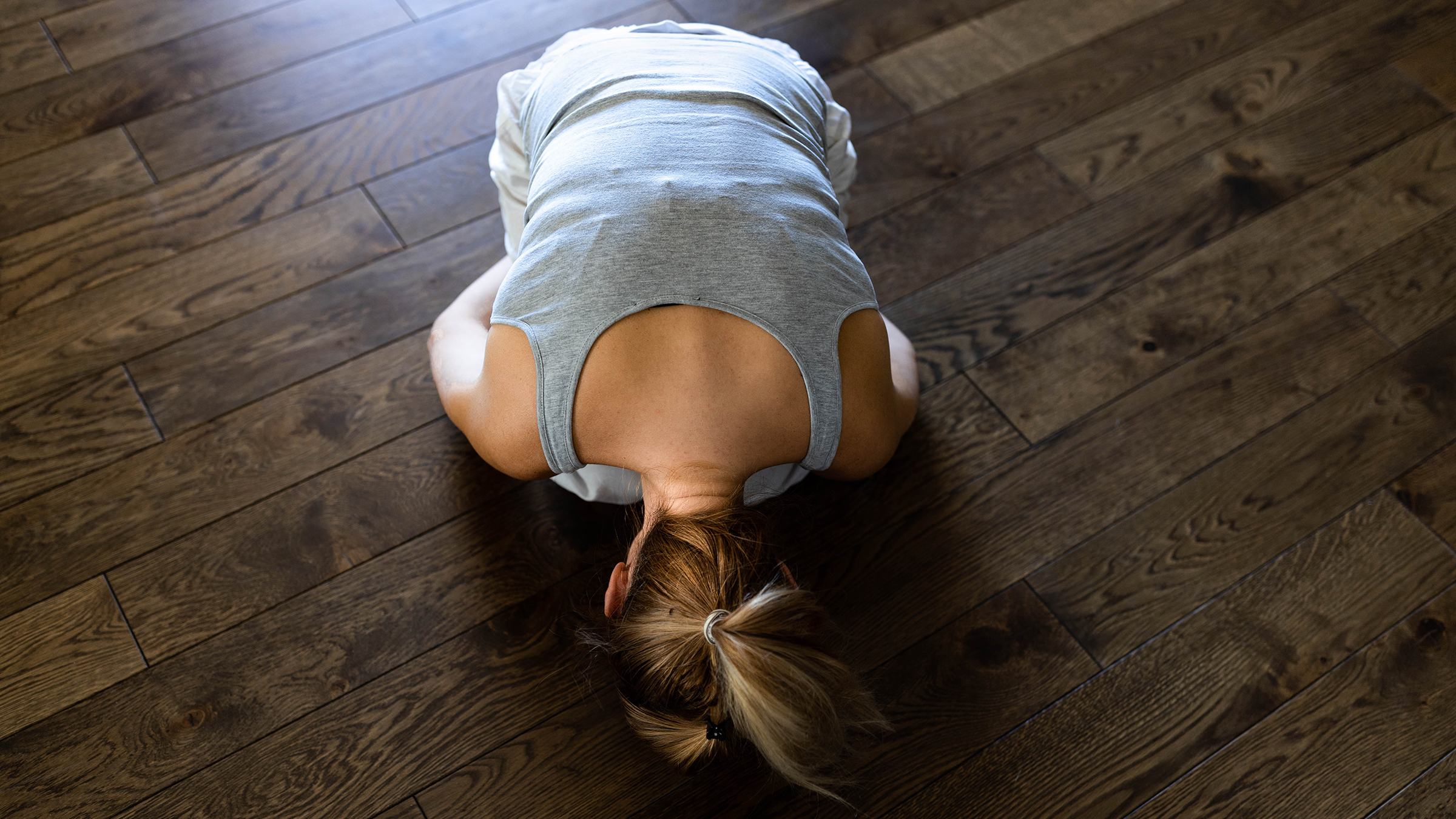

1.Bending:
While seated, tilt your head down to gaze at the floor and then up to look at the ceiling.
- Guide your head with your eyes concentrating on the floor and the ceiling.
- Repeat this process 10 times. Stop and wait for symptoms to diminish, around 30 seconds.
- Repeat the entire process 2 more times.
2.Turning (side to side):
- While seated, turn your head to the right and then to the left, leading your head with your eyes as if you are observing a tennis match.
- Turn your head at a pace quick enough to evoke symptoms but not so fast that you hurt your neck. (Start slowly, then increase speed. )
- Go back and forth 10 times, and then wait for 30 seconds (or until symptoms improve).
- Repeat the entire process 2 more times.
As the dizziness lessens:
- Perform head exercises with your eyes shut.
- Progress to standing while executing head exercises.
The closer your feet are together, the more difficult it becomes.
4)Sitting


1.Shrug shoulders – 20 times.
2.Rotate shoulders to the right and then to the left – 20 times.
3.Rotate head, shoulders, and trunk – 20 times each:
- Rotate upper body right to left with eyes open, then repeat with eyes closed.
- Rotate upper body left to right with eyes open, then repeat with eyes closed.
4.Bend forward and touch the ground then sit back up. Keep your eyes focused on the wall – 20 times.
5.Bend forward and touch the ground then sit back up. Move your eyes to the floor and back – 20 times.
6.Eye movements (head is still):
- Up and down (focusing on a finger).
- Side to side (focusing on a finger).
- Finger to tip of the nose and out (focusing on a finger).
5)Standing
1.Change from a seated position to a standing position and back again
- 20 times with your eyes open.
- Repeat this with your eyes closed.
2.Standing with one foot in front of the other,
In a corner, practice standing “heel to toe” (one foot positioned in front of the other with the heel of one foot touching the toe of the other foot) with your eyes open for 30 seconds. The objective is to maintain your balance for the full 30 seconds without contacting the wall. You can increase the difficulty by crossing your arms over your chest. If this is initially too challenging, try standing “almost heel to toe” (with your feet touching at the big toes and ankles). After mastering this with eyes open, practice it with your eyes closed.
3.Standing on a cushion
- In a corner, stand on a couch cushion or multiple pillows. Attempt to remain still without leaning against the wall for 30 seconds. Practice this with your eyes open. Once this becomes easy, practice with your eyes closed. Increase the difficulty by bringing your feet closer together. Crossing your arms over your chest also heightens the challenge. You should advance by performing this in the most difficult position possible.
4.Standing and throwing
- Toss a small rubber ball from one hand to the other above eye level.
- Throw the ball from hand to hand beneath one knee.
5.Stand with your heels together
- Look straight ahead and maintain your balance (attempt this only with assistance).
6.Stand on one foot
- Try this first with your eyes open and then with your eyes closed (attempt this only with assistance).
7.Miscellaneous
- Engage in activities that involve stooping, stretching, bending, and going up and down stairs (this should be attempted only with assistance).
6)Walking


1.Walking in a straight line
- In a hallway or beside a wall, practice walking in a straight line for 5 minutes with one foot in front of the other or “heel to toe” (with the heel of one foot making contact with the toe of the other foot). If this proves too difficult at first, practice walking “almost heel to toe” and gradually progress to heel to toe touching.
2.Walking combined with head turning
- In a hallway or open space, practice walking in a straight line while rotating your head and eyes left and right with every other step (for example, when you step with your left foot, look left; when you step with your right foot, look right). Continue this for the length of the hallway or about 20 feet. Repeat the exercise 3 times. Now repeat the entire series another 3 times, this time looking at the ceiling or the floor. You should rest between repetitions to allow symptoms to settle.
3.Walk across the room
- First perform this with your eyes open, then with your eyes closed (attempt this only with assistance).
7)Lying Down


While sitting on the side of the bed, quickly lie down to your left side, swinging your feet onto the bed as you do so.
- Remain in this position for 30 seconds or until symptoms improve.
- Repeat this 3 times.
- Now repeat this 3 times to the right.
8)Eye Exercises – Gaze Stabilization Tips


- The target must stay focused, should not be blurry, and must appear stationary while the head is in motion.
- Perform exercises with slight head movement (45 degrees on each side).
- The speed of head movement should be increased as long as the target stays in focus.
- If you use glasses, wear them during the exercises.
- These exercises may induce dizziness or nausea. Attempt to work through these feelings.
- Rest after each exercise.
- Exercises require complete concentration. Minimize distractions.
- For safety, exercises done while standing should be carried out next to a counter or with someone nearby.
9)Gaze Stabilization
Maintain your gaze on a single stationary target held in hand or located on a wall 3-10 feet away. Now move your head side to side for 30 seconds. Repeat this 3 times. Now repeat 3 times while moving your head up and down for 30 seconds. Complete 3 sessions daily.
You may advance this by starting in a sitting position, then moving to standing with feet apart, standing with feet together, standing heel to toe, marching in place, or standing on a form. This will also become more challenging if the object you are focusing on is set against a “busy wallpaper” or a checkerboard pattern.
10)Smooth pursuit
While holding a single target, keep your eyes fixed on it. Gradually move the target side to side for 30 seconds while your head remains still. Perform this in a sitting position. Progress to standing as tolerated. Now repeat the movement with your head going up and down. Repeat 20 times in each direction per session. Complete 3 sessions each day.
11)Head and eyes in the same direction
While holding a single target (like a playing card or pencil), keep your eyes focused on it. Slowly move the target, along with your head and eyes, in the same direction (up and down, side to side) for 30 seconds. Perform this while seated, and you can progress to standing as you improve. Repeat 3 times per session. This will be more challenging if you have a “background” of busy wallpaper. Complete 3 sessions daily.
12)Head and eyes in the opposite direction
Holding your target, keep your gaze fixed on it and begin to slowly move the target (up and down, side to side) while moving your head in the opposite direction of the target for 30 seconds. Repeat this 3 times per session. You may advance from sitting to standing as in the earlier exercise. Complete 3 sessions each day.
Continue to perform these exercises at least twice daily until your symptoms subside. If these exercises do not elicit symptoms, you do not need to persist with them.
Initiate a walking program at home. Aim to walk 5 days a week. Start with a 5-minute walk. Gradually increase the walking duration by 5 minutes each week until you can walk continuously for 30 minutes.
13)Summary
Vestibular neuritis workouts are a key component of the rehabilitation process since they help retrain the brain, lessen vertigo, and restore balance. These exercises, which include gaze stabilization strategies, standing and walking practice, and head and eye coordination, assist the body in adjusting to changes in the inner ear.
Patients can increase stability, gain confidence, and restore daily function by performing consistently—typically many times a day for six to twelve weeks. Although physical activity may momentarily cause dizziness, this is a natural component of retraining the balance system. Consistent effort results in substantial progress over time.
The program progressively improves balance control through simple head turns and eye focus exercises, standing heel-to-toe, walking in straight lines, and doing regulated gaze exercises. The main objective is to enable people to move about in a way that is free, secure, and free from vertigo.
If symptoms are severe, always seek the advice of an ENT expert before starting treatment and practice under supervision. Vestibular workouts can significantly improve quality of life and recovery if done consistently.
Labyrinthitis exercises
Are there any workouts for labyrinthitis that I may do at home?
Labyrinthitis, an inner ear condition that leads to dizziness and balance problems, can be controlled with home exercises designed to improve vestibular rehabilitation. Importantly, the Cawthorne-Cooksey and Brandt-Daroff exercises are crucial elements that concentrate on head and eye movements to stabilize the gaze and reposition displaced otoliths.
Incorporating physical activities like yoga, tai chi, or walking can also help to challenge the balance system and hasten the healing process.
It’s crucial to consider how each of these exercises can be easily incorporated into everyday routines for the best outcomes and a better quality of life as we investigate them.
Cawthorne-Cooksey Workouts
Cawthorne-Cooksey exercises, a key part of vestibular rehabilitation, consist of organized head and eye movements aimed at improving balance function and reducing vertigo. These exercises are especially helpful for people with labyrinthitis because they help lessen dizziness over time and promote vestibular compensation.
The main goal of Cawthorne-Cooksey workouts is to teach the eyes to move independently of the head, which enhances gaze stability and general balance.
Consistent practice can greatly enhance daily functional tasks and lessen vertigo symptoms. Adding these exercises to their practice might be quite beneficial for patients looking for natural treatments for vertigo.
The Cawthorne-Cooksey exercises’ main components are as follows:
- Head motions: Soft, regulated movements in various directions to activate the vestibular system.
- Eye movements: To enhance visual tracking, concentrate on different focal points while maintaining a steady head position.
- Gaze stabilization: Improving visual clarity during movement by concentrating on an item while moving the head.
- Relaxation of the shoulders and neck: strategies to alleviate muscle strain, which can cause lightheadedness.
- Balance training: Gradually increasing standing and walking movements to enhance postural stability.
Techniques for Repositioning Canaliths
By moving displaced otoliths back to their correct position in the inner ear, Canalith Repositioning Procedures (CRPs) provide focused interventions for treating benign paroxysmal positional vertigo (BPPV) while building on the fundamental benefits of Cawthorne-Cooksey workouts.
The Epley and Semont maneuvers are among the CRPs that use specific head and upper body motions to reposition the otoliths, or crystals, in the vestibular system, which reduces the symptoms of vertigo.
The Epley maneuver is a well-known CRP that uses a series of head movements to direct the crystals through the semicircular canals and back into the utricle. Numerous research have demonstrated the effectiveness of this method in resolving symptoms.
These maneuvers must be carried out under the direction of a vestibular physiotherapist or healthcare professional to ensure correctness and safety. These methods might make symptoms worse or lead to more discomfort if they are used incorrectly.
For this reason, professional advice and patient education are crucial to the effective application of CRPs for the treatment of BPPV in the home.
The Brandt-Daroff Exercise
The Brandt-Daroff technique is a patient-centered approach that employs gravity to reposition misplaced otoliths inside the semicircular canals, reducing vertigo symptoms.
By promoting the natural relocation of otoliths, which can interfere with normal vestibular function, these activities are logically planned motions designed to reduce the disorienting symptoms of labyrinthitis.
To execute the Brandt-Daroff exercises:
- Starting Position: With your feet flat on the ground, sit on the edge of a bed.
- Lie Down and Head Turn: Turn your head 45 degrees to one side, then lie down on the opposite side (e.g., turn left, lie on right side).
- Wait: Stay in this position for 30 seconds or until you feel less dizzy.
- Return to Starting Position: Slowly sit up and pause for 30 more seconds.
- Repeat on Opposite Side: Carry out the same procedure on the other side.
- Ideally, a healthcare professional should supervise these exercises five times on each side.
Evidence indicates that regular practice can help alleviate symptoms by reducing the frequency and severity of vertigo episodes linked to labyrinthitis through the correct repositioning of otoliths.
Including Physical Activities
Integrating physical activities like dancing and yoga into your regimen might significantly improve the vestibular rehabilitation process by retraining and challenging your balance system.
Not only do these behaviors encourage general physical health, but they also specifically target the vestibular system, aiding in its functional improvement and adaptation to changes. For example, dancing involves intricate motions and coordination, which encourages the brain to readjust spatial orientation and balance.
Yoga, with its emphasis on regulated motions and postures, may greatly help in enhancing stability and proprioception. It promotes gradual advancement, enabling people to progressively increase the complexity of their movements as their symptoms subside.
Balance and coordination can also be improved by walking, playing ball games, and engaging in different sports. These activities are crucial for desensitization and symptom enhancement since they subject the vestibular system to controlled, repetitive challenges.
It may also be helpful to gradually reintroduce activities that were previously avoided because of dizziness. To guarantee consistent and pleasurable engagement, it’s crucial to tailor these activities to your skills and interests.
According to evidence, these personalized physical exercises can improve quality of life by promoting a resilient and adaptable vestibular system, which can hasten recovery.
To sum up…
The symptoms of labyrinthitis can be effectively treated with vestibular rehabilitation therapy, which includes Brandt-Daroff and Cawthorne-Cooksey exercises as well as canalith repositioning treatments.
Activities like Tai Chi, yoga, and walking might help you improve your balance and general health.
Exercises for Vestibular Rehabilitation
Note: Before beginning any vestibular exercises, consult with a vestibular physiotherapist or healthcare professional to ensure the exercises are suitable for you.
1. VOR Regular Standing / Gaze Stabilization
Here’s a modification to test out if keeping your gaze steady on one leg is too challenging for you.
Intended Benefits
- Expected Advantages
- Enhance vision
- Encourage the capacity to concentrate on motionless things even when the head is moving.
- Encourage general gains in balance and movement
The Exercise‘s Instructions
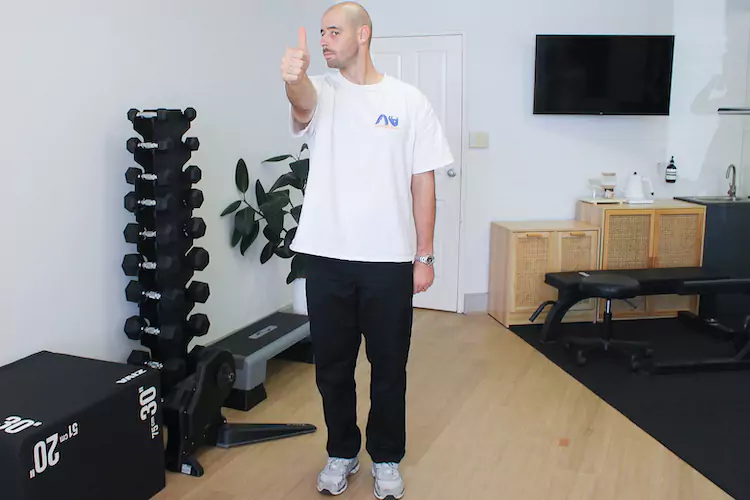

- Maintain a shoulder-width between your legs as you stand on them.
- Focus on a letter, your thumb, or something at eye level in front of you.
- Keep your attention on your target and keep your balance as you slowly turn your head from side to side.
- Continue performing gaze stabilization until you feel little to moderate vertigo.
- To aid your brain in adjusting, try to increase the duration of this exercise (up to one minute).
- Increase the frequency of this workout to three to five times daily.
Note: If you are unable to stabilize your gaze while standing, begin by practicing it while sitting.
2. VOR Single Leg / Gaze Stabilization
Planned Advantages
- Make your eyesight better.
- Encourage the capacity to concentrate on motionless things even while the head is moving.
- Encourage general improvements in balance
- Assist in the treatment of inner ear injuries
The Exercise’s Instructions
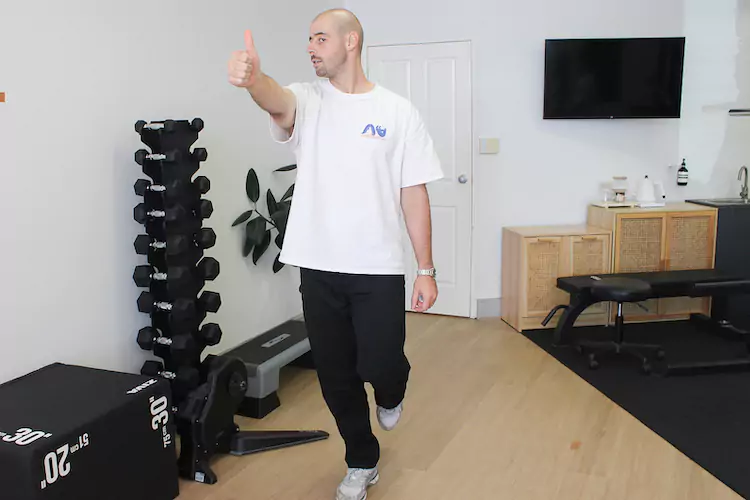

- Maintain your balance on one leg
- Concentrate on a letter, your thumb, or something else that is directly in front of you at eye level.
- Keep your gaze fixed on your target while turning your head from side to side at a moderate pace, keeping your equilibrium on one leg.
- Maintain gaze stabilization until you experience mild to moderate vertigo.
- To help your brain adjust, work your way up to doing this exercise for longer durations of time (up to a minute).
- Work your way up to doing this activity three to five times each day.
Note: This activity may be modified and progressed in a number of ways. I advise beginning with gaze stabilization while standing on both legs (which I will discuss later in this piece) if standing on one leg is too difficult.
Try moving your head faster or up and down rather than side to side to make gaze stabilization more challenging.
3. Vestibular Proprioception Training Using Laser or Mirror
Planned Advantages
- Enhance spatial awareness and proprioception
- Enhance reflexes between the neck and the eye
The Procedure for Performing the Exercise


- Use a whiteboard marker to draw an X on your mirror.
- Place yourself in front of the mirror so that the vertical line passes through the middle of your eyes.
- Close your eyes, move your head to the left, and then go back to the point where you believe the line will cross the center of your eyes.
- Take a look and see for yourself.
- Repeat the process five to ten times on each side, making changes as necessary.
4. Head Turns While Walking
Planned Advantages
- Enhance total equilibrium
- Help boost vestibular endurance and efficiency.
- lower dizziness sensitivity
- Improve mobility
The Steps of the Exercise
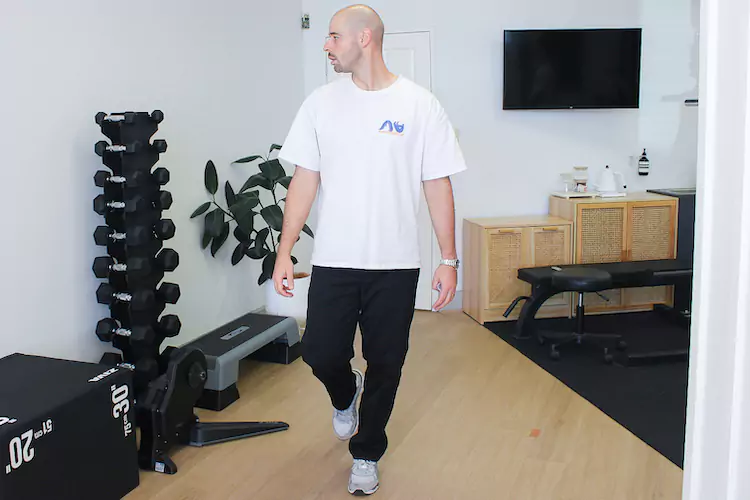

- Turn your head gently and smoothly from side to side as you walk.
- Try walking in a straight line while turning your head from left to right and from right to left.
- Make an effort to coordinate your steps with the direction in which you turn your head (e.g., step with your right foot, look to the right).
- Begin by walking and moving your head from side to side for the entire length of the hallway, and gradually increase your time to one minute at a time.
- Take a break before completing the procedure three times altogether.
Take note: I advise doing this in a hallway after consulting with a healthcare expert to determine whether it’s a good workout for you. If you get a little off balance in a hallway, the nearby walls offer a decent stabilization choice.
5. Saccades
Planned Benefits
- better head and eye movement control
- Increase vestibular efficiency and endurance
- Increase the brain’s tolerance to dizziness in order to lessen the symptoms of vertigo and dizziness.
The Procedure for Performing the Exercise
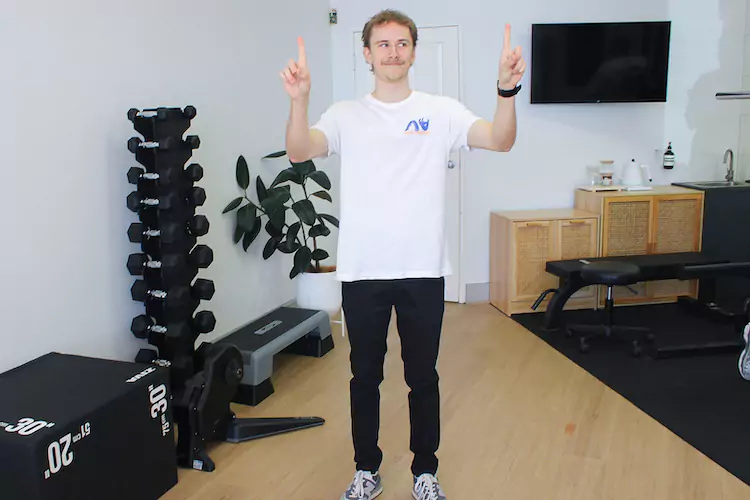

- Maintain a distance of approximately 80 cm between your two index fingers while holding them out in front of you at arm’s length.
- Keep your head still and quickly move your eyes to concentrate on your right index finger.
- Once gaze is steady, quickly move it to the left index finger without moving your head.
- Continue this procedure between the two fingers.
- You can use markers on the wall in front of you, such as playing cards, if you are unable to hold your arms out in front.
Note: I suggest doing this exercise while sitting or standing in front of a wall. Whatever position you find most comfortable is a good place to begin. Use a timer on your phone to keep track of your rounds with ease.
6. Use ball throwing to balance yourself.
Planned Advantages
- Enhance hand-eye coordination
- Improve overall balance
The Exercise’s Instructions
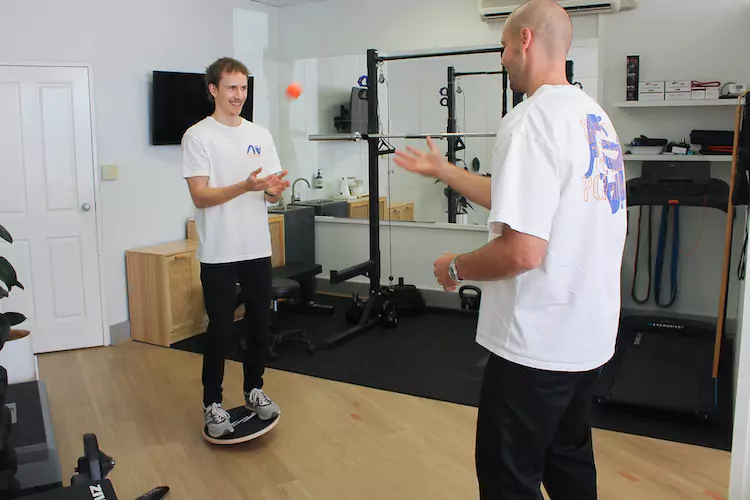

- At about eye level, toss a little rubber ball between your hands.
- Then, raise one leg and toss the ball between your hands under one knee.
- Do it again on the other leg.
- Sit in a chair and toss a tiny ball from hand to hand at just above eye level if the standing postures are too challenging.
- Attempt three rounds of 30 seconds of throwing.
7. Easy Follow
Targeted Advantages
- Aid in fostering healing after an inner ear injury
- Help lessen the symptoms of dizziness.
- Help retrain the mind
The Exercise’s Instructions
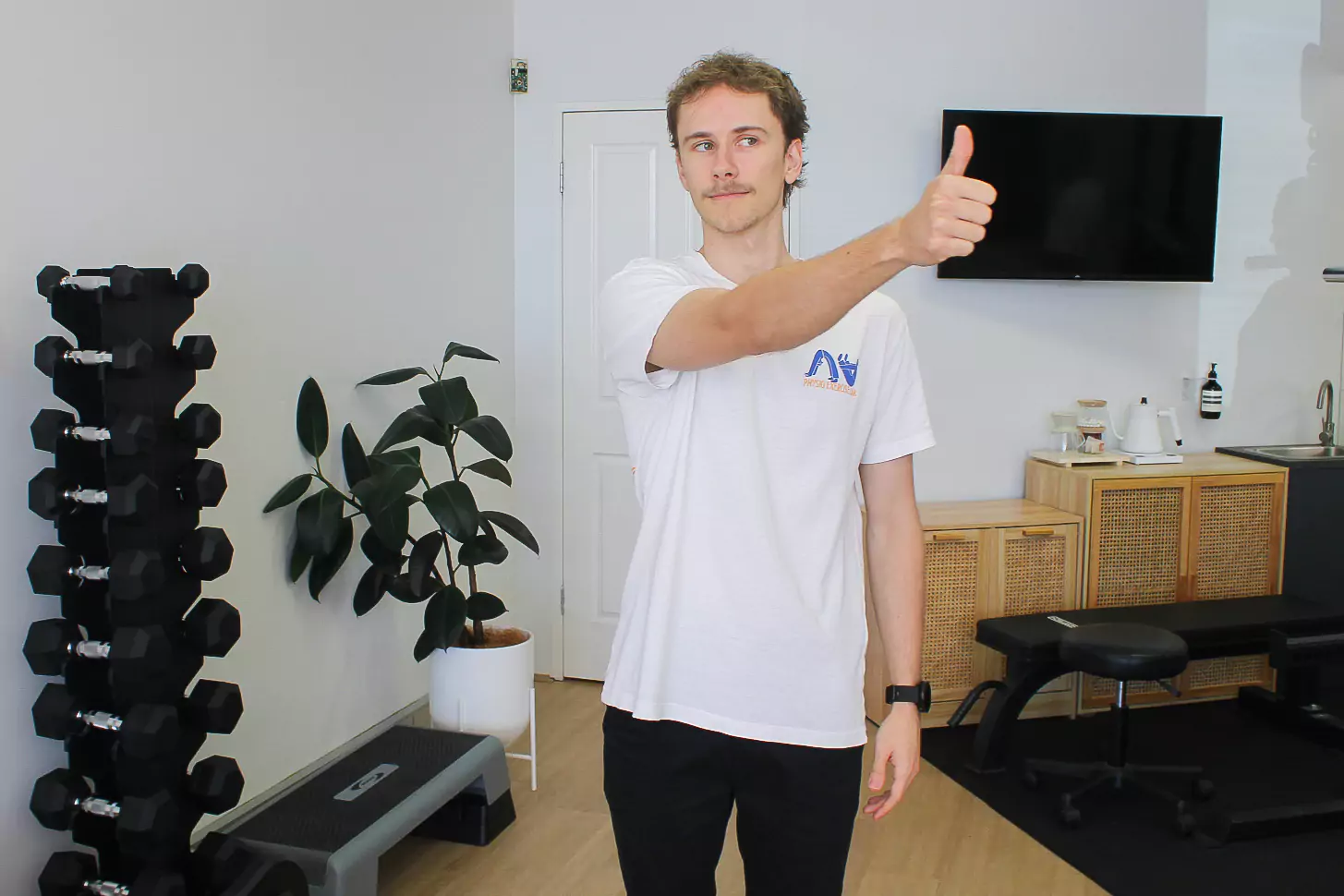

- Keep just one thing in front of you.
- Maintain focus on the objective
- To maintain a steady head, slowly move the target side from side to side.
- Try to accomplish this for 30 seconds.
- Try this while standing if you can do it well in the sitting posture.
8. Improved Romberg Stance / Tandem Stance Balance
Desired Outcomes
- Enhance balance and stability
- Lower the chance of falling
- Increase vestibular efficiency and proprioception
How to Do the Exercise
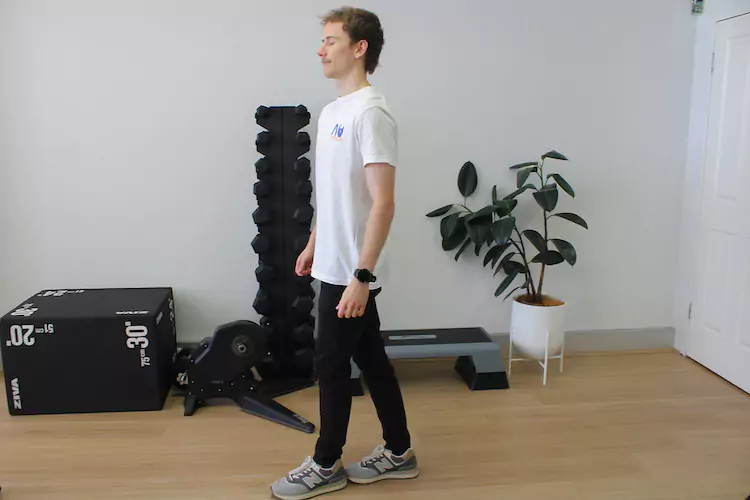

- Place your feet heel to toe in an open space.
- Close your eyes after settling into this position.
- Try to maintain this posture for as long as you can – ideally for more than 30 seconds..
FAQs
What are vestibular exercises?
Vestibular activities are designed to test balance and induce dizziness. You may develop a tolerance for dizziness in your brain by intentionally inducing it under supervision through vestibular rehabilitation exercises. Similar to how some exercises strengthen your muscles, vestibular physiotherapy routines are intended to improve your balance and cognitive function.
What is vestibular physiotherapy?
Specialized physical therapy known as vestibular physiotherapy aims to treat balance and dizziness problems brought on by vestibular system problems. The vestibular system is made up of the components of the inner ear and brain that are responsible for maintaining balance and regulating eye motions.
What are the mechanisms behind vestibular exercises?
The vestibular system is stimulated during vestibular activities, which retrain the brain. This stimulation is intended to cause dizziness and imbalance. The brain learns to tolerate dizziness by being subjected to it repeatedly. Through vestibular rehabilitation activities tailored to each patient’s individual needs, I have witnessed significant improvements in their balance and mobility. I like seeing patients say they have less dizziness and are more able to do their everyday activities.
What are the advantages of vestibular rehabilitation therapy?
The following are some potential advantages of vestibular rehabilitation therapy:
- Practice moving the eyes separately from the head
- Treat inner ear injuries
- Train the mind once more
- Enhanced general equilibrium
- Better understanding of one’s muscles
- Increasing Vertigo and Dizziness
- enhanced quality of life
- Increased stability
- greater assurance in carrying out everyday activities
- Greater freedom of movement
- Less chance of tripping
Do you have any recommendations for beginning vestibular rehabilitation exercises?
I only advise doing vestibular rehab exercises under the guidance of a physiotherapist. A certified physiotherapist will teach you how to do the exercises safely, identify necessary adjustments, and make sure you do them correctly.
When starting vestibular therapy workouts, I provide my patients with the following advice:
- A little vertigo is to be expected, but discontinue the vestibular treatments if it gets bad.
- As you conduct vestibular physiotherapy exercises, have another person there.
- Work with a trained physiotherapist who can oversee your advancement.
- Begin slowly and make changes as necessary.
- Keep things the same.
- Take a break until your next session if you are still experiencing nausea.
For important health related topics please click on our facebook page link given below or copy paste this link into google search –
https://www.facebook.com/positivemind.healthcare
For important health related videos please click on the link of our youtube channel given below or copy paste this link into google search-
http://www.youtube.com/@healthuseful8539/
Do you need assistance with your vestibular exercises?
Exercises in vestibular physiotherapy can be a key component of lessening the symptoms of vertigo and enhancing general balance.
Although some of these vestibular rehabilitation exercises may be done at home, they are best carried out under the guidance of a physiotherapist.
Our physiotherapists at the Physio and Exercise Lab focus on treating balance problems, dizziness, and other indications of vestibular illnesses.
We use cutting-edge assessment methods to pinpoint the underlying cause of your symptoms and figure out which vestibular exercises will help you restore your quality of life.
Our objective is to enhance your general well-being, lessen dizziness symptoms, and help you regain your self-assurance in performing your daily activities by employing a fully non-invasive method and focused vestibular workouts.









